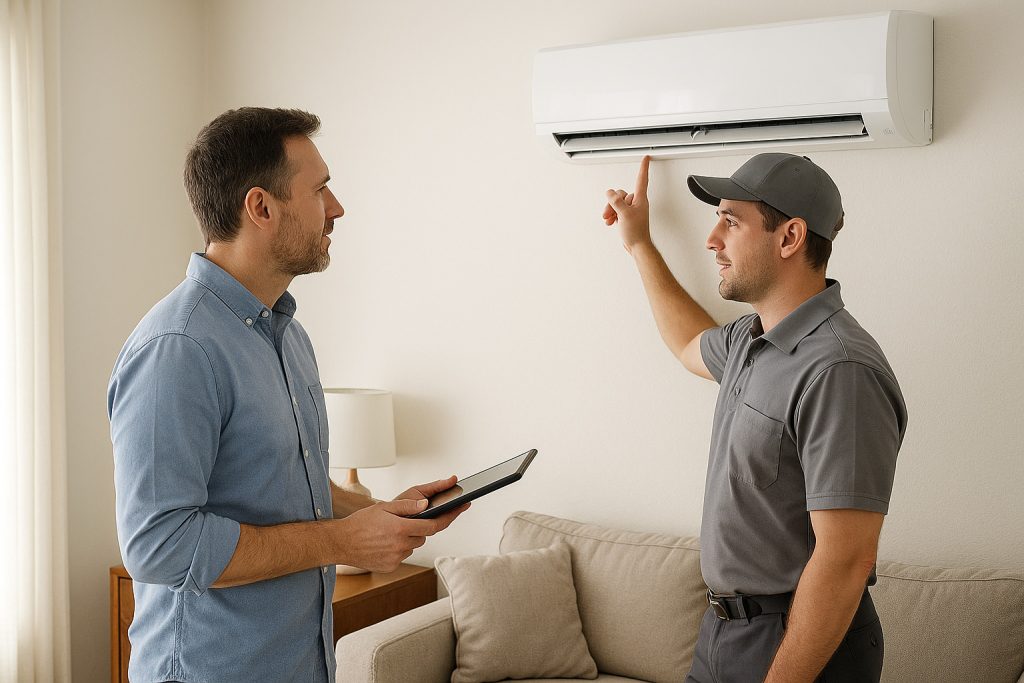If you live in Pennsylvania and find yourself battling inconsistent temperatures from room to room – like an upstairs that swelters in summer while the downstairs stays cool, or that one stubborn room that just never feels quite right – you’re not alone. Many homeowners face this common comfort challenge.
Maybe it’s your work-from-home office that overheats midday, or the baby’s room that’s always too chilly. Understanding why these temperature inconsistencies happen and how ductless mini-split systems can solve them is key to achieving consistent comfort throughout your home.

Why Do Hot and Cold Spots Happen?
Several factors can cause uneven heating and cooling in a home, especially with traditional forced-air HVAC systems:
- Poor or leaky ductwork – Traditional HVAC systems rely on ductwork to distribute air from a central unit to each room. If ducts are improperly sized, damaged, or have leaks, conditioned air escapes before reaching its destination. This leads to some rooms getting less airflow, causing temperature imbalances.
- Room location and sun exposure – Rooms facing direct sunlight or located farthest from the HVAC unit often experience more extreme temperatures. An upstairs bedroom with large south-facing windows may become unbearably hot in summer, while a basement office might stay cool and damp.
- Poor insulation – Inadequate insulation in walls, attics, or crawl spaces lets heat penetrate in summer and escape in winter, making it difficult for your HVAC system to maintain even temperatures.
- Closed or blocked vents – Sometimes the culprit is as simple as a closed vent or furniture blocking airflow to a room. Even partial obstruction restricts air delivery, creating hot or cold spots.
- Additions or renovations – Rooms added after the original HVAC installation may not be properly integrated with existing ductwork, resulting in inadequate airflow and comfort issues.
How Ductless Mini-Splits Address Temperature Inconsistencies
Unlike traditional HVAC units, mini-splits don’t use ductwork to move air. Instead, they use a simple yet effective setup:
- Outdoor condenser unit – This component extracts heat from outside air for heating, or releases heat outdoors for cooling.
- Indoor air handlers – Mounted on walls or ceilings, these units distribute conditioned air directly into rooms.
- Refrigerant lines and wiring – These connect the outdoor and indoor units without requiring bulky ductwork.
This technology allows you to install one or more indoor units strategically throughout your home – one for the baby’s nursery, another for the home office, and others for bedrooms or living areas – each with independent temperature controls.
Benefits of Ductless Mini-Split Systems
- Consistent zoned comfort – You can set different temperatures for each room, eliminating hot or cold spots and ensuring every space stays comfortable year-round.
- Energy efficiency – Because you’re only conditioning the rooms you’re using, mini-splits reduce energy waste and can lower your utility bills.
- No ductwork needed – This makes installation easier, especially in older homes without existing ducts or in rooms added after the original construction.
- Improved indoor air quality – Mini-splits use advanced filtration systems that help reduce dust, allergens, and pollutants in the air.
- Quiet operation – Both indoor and outdoor units operate quietly, so you won’t be disturbed in bedrooms or workspaces.
Contact Regal Plumbing, Heating and AC to schedule an appointment for a ductless mini split. Committed to Service, Committed to You, Since 1974.
